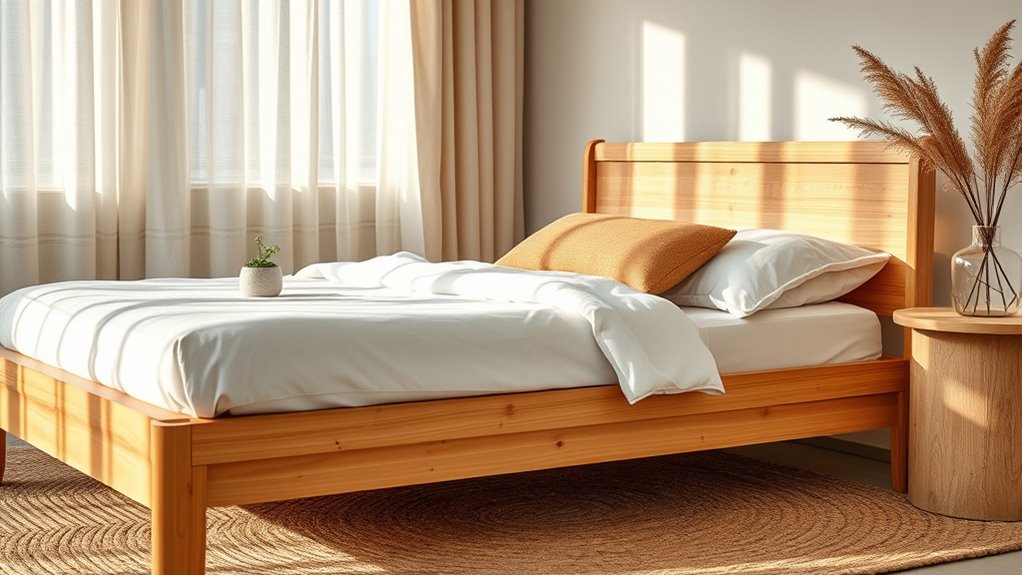Transform your sleep space with sustainable materials like bamboo and cork, which are eco-friendly, durable, and naturally antimicrobial. Choosing reclaimed wood or recycled textiles keeps waste low and minimizes your environmental impact, while natural insulation options like wool, hemp, and cellulose help regulate temperature and improve air quality. Using these conscious choices creates a healthier, more relaxing bedroom that supports both your well-being and the planet—discover more ways to craft your eco-friendly haven below.
Key Takeaways
- Bamboo is a fast-growing, renewable material ideal for eco-friendly furniture and decor in your sleep space.
- Cork is a sustainable, biodegradable material that provides natural sound absorption and antimicrobial properties.
- Reclaimed wood offers an eco-conscious option for bed frames and furniture, reducing waste and conserving resources.
- Using recycled textiles and natural fibers in bedding and cushions minimizes environmental impact and enhances comfort.
- Incorporating eco-friendly insulation like wool, hemp, or cellulose improves energy efficiency while supporting sustainability.

Creating a sleep sanctuary that’s both comfortable and eco-friendly is easier than you might think. One of the key ways to achieve this is by choosing sustainable materials that prioritize environmental health without sacrificing comfort. When it comes to insulation, eco friendly options like wool, hemp, or cellulose are excellent choices. These materials are renewable, biodegradable, and often produced with lower energy consumption than conventional insulations. Wool, for example, naturally regulates temperature and resists mold and pests, making it a practical and sustainable solution. Hemp insulation is lightweight, durable, and grows rapidly, requiring minimal water and no pesticides. Cellulose insulation, made primarily from recycled paper, reduces waste while providing effective thermal barriers. These options not only insulate your space efficiently but also help reduce your carbon footprint.
Choose eco-friendly insulation like wool, hemp, or recycled cellulose to create a sustainable, comfortable sleep sanctuary.
Recycled textile options are another smart way to make your sleep space greener. Instead of tossing out old fabrics or buying new, you can repurpose textiles or choose products made from recycled materials. Many companies now produce bedding, mattress covers, and pillows using recycled polyester or other reclaimed fibers. These textiles often come with certifications that ensure they’re environmentally friendly and free from harmful chemicals. Using recycled textiles contributes to reducing landfill waste and decreases the demand for virgin materials, making your bedroom a part of the circular economy. You’ll find comfort in knowing your choices support sustainability while still enjoying soft, cozy bedding.
In addition to insulation and textiles, incorporating eco friendly insulation and recycled textile options into your sleep sanctuary can extend to furniture and decor. Look for beds made from reclaimed wood or sustainably harvested bamboo, which grows quickly and requires minimal resources. Cork is another versatile, renewable material that’s naturally antimicrobial and provides excellent sound absorption. Its sustainability comes from harvesting cork bark without harming the tree, making it an ideal choice for eco-conscious design. Additionally, the use of high-performance projectors in your space can help create a relaxing atmosphere without increasing energy consumption, aligning with your eco-friendly goals. When selecting accessories, opt for items crafted from recycled or natural materials, avoiding plastics and synthetic finishes that can off-gas harmful chemicals.
Ultimately, building an eco-friendly sleep sanctuary involves mindful choices across all elements. By selecting eco friendly insulation options, utilizing recycled textiles, and choosing furniture made from sustainable materials, you create a space that nurtures both your well-being and the planet. It’s about making conscious decisions that align comfort with environmental responsibility, turning your bedroom into a true haven for relaxation and sustainability.
Frequently Asked Questions
Are Sustainable Materials More Durable Than Traditional Options?
Sustainable materials can be just as durable, if not more so, than traditional options, thanks to their inherent material longevity. You’ll find that bamboo, cork, and other eco-friendly choices often have excellent environmental benefits while standing the test of time. By choosing sustainable materials, you not only reduce your environmental footprint but also enjoy long-lasting furniture and bedding that maintain their quality over years.
How Do Sustainable Materials Impact Indoor Air Quality?
Think of sustainable materials as a gust of fresh air in your home. They typically emit fewer chemical emissions, leading to air quality improvement. By choosing eco-friendly options like bamboo or cork, you help reduce indoor pollutants, creating a healthier sanctuary. This cleaner environment means you breathe easier and sleep better, knowing your space supports your well-being while minimizing chemical exposure. Your sanctuary becomes a true haven for health and relaxation.
Can Sustainable Materials Be Customized for Different Mattress Types?
Yes, sustainable materials can be customized for different mattress types. You can explore a variety of customization options, ensuring compatibility with your mattress. Whether you have a memory foam, latex, or innerspring mattress, eco-friendly options like organic cotton, natural latex, or bamboo covers can be tailored to fit your needs. This customization allows you to create a sleep environment that’s both sustainable and perfectly suited to your mattress.
What Is the Cost Difference Between Sustainable and Conventional Materials?
Like comparing apples and oranges, the price difference between sustainable and conventional materials varies. Generally, sustainable options like bamboo and cork have higher material costs, making them more expensive upfront. The price comparison depends on quality and sourcing, but eco-friendly materials often cost 10-30% more. However, you might save in the long run through durability and health benefits, making the investment worthwhile for your sleep sanctuary.
Are Sustainable Materials Suitable for Allergy-Sensitive Sleepers?
Yes, sustainable materials like bamboo and cork are suitable for allergy-sensitive sleepers. They often have hypoallergenic properties, making them resistant to dust mites, mold, and bacteria. If you have chemical sensitivities, you’ll appreciate that these natural options typically contain fewer chemicals and toxins compared to conventional materials. This creates a safer, healthier sleep environment, especially for those prone to allergies or sensitivities.
Conclusion
By choosing sustainable materials like bamboo and cork, you’re not only creating a cozy sleep sanctuary but also supporting the planet. Many believe that natural, eco-friendly options can improve sleep quality by reducing allergens and toxins. While some skeptics question their durability, the growing popularity and scientific backing suggest these materials truly make a difference. So, when you opt for sustainable choices, you’re fostering a healthier environment—and a more restful, guilt-free sleep.









